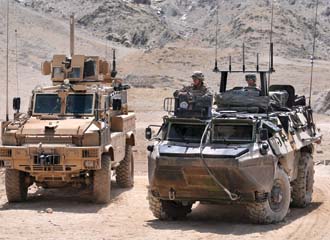It's Time to Move From Net-Centric to Data-Centric
 |
A U.S. mine resistant ambush protected vehicle and a French tactical armored vehicle bring troops back to their base from a mission in Afghanistan. Future military networks must be configured to enable |
The path to achieving the vital goal of coalition interoperability may require abandoning longtime networking tenets in favor of a data-centric or knowledge management approach. Today, many key programs lack joint and coalition interoperability. Despite these programs’ capabilities, building a future mission network requires coalition interoperability—a capability that cannot be overlooked, but can be incorporated by taking a new approach.
In the past 100 years, military communication technology has evolved from the pigeon and courier to satellites and network computing. During World War I, information could be segregated by pigeon and by courier, and by 1996 this could be accomplished through radio frequency or server terminal segregation. But in 1966, the Advanced Research Projects Agency (ARPA) built the ARPANET by linking multiple point-to-point server terminals into a single terminal. The result was increased information sharing and a move from server terminals to network terminals.
However, because of the reliance on network technology, the problem ARPA solved in 1966 has come full circle. Instead of multiple server terminals, multiple network terminals serve as barriers to information sharing. Efforts to secure information through physical and cryptological separation have seen networks evolve from a single ARPANET into 15,000 Defense Department enclaves, domains and networks. At a time when information sharing has become critical to military success, the enabling technology has created the same barriers to information sharing that forces had with server terminals. Securing information is important, but the time may have come for the military to reduce reliance on networks and evolve to a data-centric model.
One disadvantage of the current net-centric model is that another network terminal must be added to an already burdensome command, control, communications, computers and intelligence (C4I) integrated capability. Much like the problem that ARPA faced in 1966, more terminals to communicate with more groups is not the answer. For the United States, tactical units must decide on a configuration of a single or multiple coalition mission network(s) in addition to the nonsecure Internet protocol router network (NIPRNET) and the secret Internet protocol router network (SIPRNET), or they must remove NIPRNET to make room in confined rack space.
Additionally, despite a requirement to plan and participate in coalition wars, the current model allows the U.S. Army, Navy, Air Force and Marines, as well as each coalition partner, to pursue disparate information technology strategies with little regard to coalition interoperability. Applications such as the Army’s Command Post of the Future and the Air Force’s Theater Battle Management Core Systems lack any joint or coalition interoperability.
A data-centric model removes the need for application interoperability. As planners consider options for the future mission network, they must address policies and practices that enable service-specific or nation-specific solutions by focusing efforts on data interoperability. The first step to evolving from a net-centric model and building the future mission network must be the revision of national policies. This will require standard data structures, data exchange standards and procuring technology capability that supports knowledge management.
Focusing on data interoperability instead of transport and application can reduce costs and inefficiencies associated with application interoperability and network data segregation, while also increasing information availability. Similarly, pursuing existing cloud technology and investing in evolving technology that addresses challenges in strong identity management— such as public key infrastructure, role-based access control and biometrics—along with data optimization/standardization, data security and data analytics, will help address defense information security needs while increasing information discoverability and sharing.
Decision making is a result of data analysis, course of action (COA) development and, finally, COA selection. Leaders usually make decisions after carefully considering all available and relevant information. Yet, no leader makes decisions based on the information technology variables of transport, network/domain or application. Instead, these information technology variables assist in data and information availability, reliability and analysis. Knowledge management variables are far more significant than any information technology variable. Yet, with more than 15,000 Defense Department networks, enclaves and domains in existence—28 within the U.S. Central Command area of responsibility—a commander may find that the mission-critical information required for adequate decision making is unavailable because it is on another network.
Focusing on the information sharing problem in addition to the information security requirement requires an evolution from a 1980s net-centric model to a more relevant data management model. Instead of a solution based on the number and types of networks, planners can build solutions addressing content classification, data security, information management and identity management. More importantly, they also can address the problem of disparate data across multiple networks and the possibility for a single future coalition mission secret network supporting multiple communities of interest (COIs).
NATO and U.S. planners are struggling with the questions of whether a single network could succeed and how existing cultural and policy barriers can be removed to transition to a data-centric model. The technology either exists or could be developed; but without Defense Department and NATO policy changes as well as an acceptance of current technology over network technology, little incentive exists to change.
Evolving from a net-centric information security model to a data-centric knowledge management model requires change. Pursuing a knowledge management model builds upon existing network technology but elevates the need to acquire, store, analyze and make information available to registered members, similar in theory to library management. It requires a change from network classification and information segregation to information classification and segregation. Furthermore, current technology resolves many of the problems created by network segregation by virtualizing information, making the physical location and network less important than information classification.
While U.S. and coalition partners have excelled at collecting information by employing manned and unmanned sensors, satellites and well-trained personnel, they have lagged in making this information available for analysis. Similarly, while technology has evolved in the 30 years since the first network, cloud solutions based on enterprise service bus, Web-oriented or service-oriented architectures have not been pursued sufficiently by military organizations. Unlike the current net-centric model, these cloud technologies have the ability to make relevant and reliable information available, regardless of network or location.
Instead of limiting access to information by network and requiring information to be replicated across multiple networks for greater availability, improved information sharing policies would be network agnostic. Current information security and network policies could be hurdles to cloud solutions; but by refining security and technology policies, cloud computing could improve information sharing. Policies that enable Defense Department and coalition partners to make information available based on content classification, a user’s identity, role and COI membership (need to know)—instead of network, domain or enclave for each COI/mission—support knowledge management requirements.
Unlike operation Iraqi Freedom, where 94 percent of all forces were U.S. troops, operation Enduring Freedom in Afghanistan is being fought by forces from 48 countries, with 28 percent coming from coalition nations. Likewise, unlike in Iraq, when unity of command was central to U.S. operations, Afghanistan emphasized unity of effort as well as unified coalition command, control, collaboration and information sharing. Afghanistan’s mission requirements changed how the military communicates, much the same way that World War II radio technology eliminated the need for pigeons. No longer could forces operate on separate national networks, because increased coalition participation and force diversity require a single coalition mission network—the Afghanistan Mission Network (AMN).
Unlike previous networks, the AMN is a federation of multiple national networks with a non-national—the International Security Assistance Force (ISAF)—network hub. By design, this model avoids national policy issues by using national networks as spokes and a coalition as the hub. With a coalition hub, national sovereignty and policy are maintained with all the countries and their networks as equals. It requires nations to exercise their own security, classification and disclosure policies. Similarly, the coalition’s joining and governance policies subordinate each national extension to the coalition mission requirement. A nation such as the United States can serve as the hub without violating its own national policy or subordinating other nations.
By building networks built around data-centric standards, militaries will be able to create federated networks that will meet national and coalition needs. Most importantly, the allies will not lose what has been gained from the evolution of the AMN.
Lt. Col. Scott Harrison, USAR, is a U.S. Army Reserve medical operations officer on active duty at U.S. Central Command J-6. In his civilian career, he is an IBM Global Services senior consultant and executive project manager.




Comments